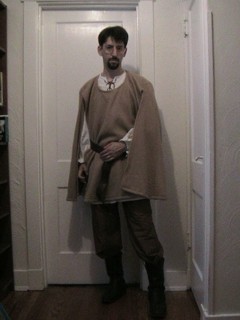Tabard Cape
Garb Jacket

January 2005

January 2005

Back in the summer of 2004, when I was making a bunch of medieval garb for Pennsic, I decided to make a tabard cape to wear over some of the things I'd made. A tabard is usually just a rectangle that goes on over the head and hangs down in the front and back. A cape is usually a 1/2 or 3/4 circle that ties at the neck and hangs down the back and perhaps over the arms. The tabard cape combines these two garments. You above can see that it hangs down in front (where it's tucked under my belt) and that it wraps around the back and sideds. Not all tabard capes have the sides sewn to the back as mine does, some have them hanging separately, or even have buttons so that they can be closed up into sleeves.
Basically, tabards, capes, and tabard capes are short, often only coming down to thigh or knee level, worn over other garments to display livery or just keep warm. "Keep warm?" you ask, "Isn't Pennsic in August?" That's true, but some Pennsics it gets quite chilly at night. Sometimes as low as the mid forties. There have been reports of snow at Pennsic.
Now, I had a pattern for making a tabard cape, but I was in a hurry, and not up for much sewing at that point, so I just took the pattern and cut a similar shape out of a big piece of polar fleece. It was useful, but nowhere near proper. At Pennsic that year, I found some nice wooly fabric, so I decided to actually follow the pattern and make a more proper version.

Really, it's just this fuzzy, beige, wool-blend fabric and nothing else besides thread. At first, I thought it was 100% wool, but while ironing down the seams I discovered that it is at least partially polyester or something that I had to clean off the iron after it cooled.
I had a pattern, but as amazing at it might seem for such a simple garment, the pattern was pretty sucky. Starting with the cutting instructions that caused me to not buy enough fabric and then wanted me to place the pattern pieces on that fabric in a way that was impossible. Proceeding through not giving good tips for placing the neck hole, and giving only vague descriptions of the neck facings. Ending up with not making it clear which stress points will need to be reinforced.
Anyway, I survived, and actually think this came out very nice, but it wears a little funny. I embellished the pattern by sewing the seam allowances down inside, which gives the outer surface a decorative look around the seams. If I'd known it was going to come out looking so nice, I would have tried to figure out how to line it so that it would look really nice.